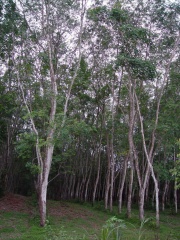Difference between revisions of "Caoutchouc"
| Line 4: | Line 4: | ||
== Description == | == Description == | ||
| − | A French term used in Brazil for the | + | A French term used in Brazil for the milky sap, or latex obtained from various tropical plants from the species ''Hevea'' and ''Ficus''. Caoutchouc is a natural rubber composed of polymers of isoprene along with minor impurities of other compounds. It has the capacity for reversible deformation at room temprerature. In 1738, a French research, de la Condamine, presented it's properties, The iin 1839, C. Goodyear discovered theprocess of vulcvanizations., the name caoutchouc was also used for a commercial rubber-based cement in which a small amount of the elastomer was dissolved in a solvent and mixed with mastic. Today, the material is preferentially called [[latex]] or liquid rubber. |
== Synonyms and Related Terms == | == Synonyms and Related Terms == | ||
| Line 27: | Line 27: | ||
== Sources Checked for Data in Record == | == Sources Checked for Data in Record == | ||
| + | * The Free Distionary [https://encyclopedia2.thefreedictionary.com/Rubber%2c+Natural#:~:text=Rubber%2C%20Natural%20caoutchouc%2C%20crude%20rubber%2C%20a%20polymer%20of,considerable%20reversible%20deformation%20at%20room%20temperatures%20and%20lower history] | ||
* Random House, ''Webster's Encyclopedic Unabridged Dictionary of the English Language'', Grammercy Book, New York, 1997 | * Random House, ''Webster's Encyclopedic Unabridged Dictionary of the English Language'', Grammercy Book, New York, 1997 | ||
Revision as of 13:53, 5 August 2020
Description
A French term used in Brazil for the milky sap, or latex obtained from various tropical plants from the species Hevea and Ficus. Caoutchouc is a natural rubber composed of polymers of isoprene along with minor impurities of other compounds. It has the capacity for reversible deformation at room temprerature. In 1738, a French research, de la Condamine, presented it's properties, The iin 1839, C. Goodyear discovered theprocess of vulcvanizations., the name caoutchouc was also used for a commercial rubber-based cement in which a small amount of the elastomer was dissolved in a solvent and mixed with mastic. Today, the material is preferentially called Latex or liquid rubber.
Synonyms and Related Terms
latex; caucho (Esp.); latex (Fr., Port.); caucciù (It.); liquid rubber; rubber latex; elastic gum; India rubber; elastic bitumen; rubber cement; weeping wood; caout-rubber;
| Density | 0.92-0.99 |
|---|
Additional Images
Sources Checked for Data in Record
- The Free Distionary history
- Random House, Webster's Encyclopedic Unabridged Dictionary of the English Language, Grammercy Book, New York, 1997
- G.S.Brady, Materials Handbook, McGraw-Hill Book Co., New York, 1971 Comment: p. 675
- Matt Roberts, Don Etherington, Bookbinding and the Conservation of Books: a Dictionary of Descriptive Terminology, U.S. Government Printing Office, Washington DC, 1982
- Dictionary of Building Preservation, Ward Bucher, ed., John Wiley & Sons, Inc., New York City, 1996
- Susan E. Schur, Conservation Terminology: A review of Past & Current Nomenclature of Materials, Technology and Conservation, Spring (p.34-39); Summer (p.35-38); Fall (p.25-36), 1985
- George Savage, Art and Antique Restorer's Handbook, Rockliff Publishing Corp, London, 1954
- Edward Reich, Carlton J. Siegler, Consumer Goods: How to Know and Use Them, American Book Company, New York City, 1937
- CRC Handbook of Chemistry and Physics, Robert Weast (ed.), CRC Press, Boca Raton, Florida, v. 61, 1980 Comment: density=0.92-0.99


